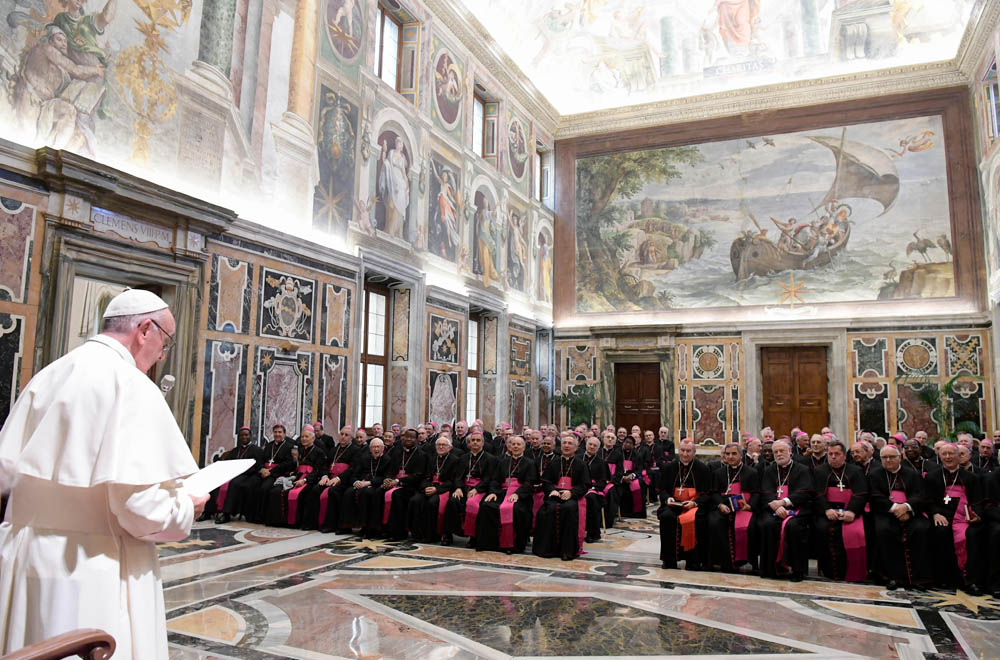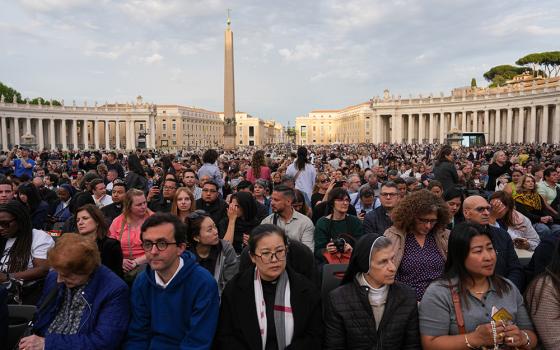
Pope Francis speaks during a meeting with nuncios, who represent the pope around the world, in the Apostolic Palace at the Vatican Sept. 17, 2016. (CNS/L'Osservatore Romano, handout)
On Friday, I began my review of Jesuit Fr. John O'Malley's Vatican I: The Council and the Making of the Ultramontane Church, examining what the 19th century church was reacting against. This set the table for the introduction of Joseph de Maistre, the Savoyard layman and provocateur who became the champion of Ultramontanism, among other reactionary ideals.
I do not want to give away the heart of the book, except to say that O'Malley offers a thoughtful and comprehensive treatment of the various events and personalities that shaped the clamor which would lead to the definition of papal infallibility at the First Vatican Council. Instead, I want to highlight some of those events and movements which seem to be still normative for the church we know today and a couple of items about which I had previously not known.
In the latter category, and in light of the controversies that surrounded the new English translation of the missal, I was surprised to learn that it was only in the mid-19th century that the church in France adopted the Roman Missal. Previously there were different rites throughout France. I had not thought of the liturgical renewal launched at the Abbey of Solesmes was a part of the move to Ultramontanism, but O'Malley demonstrates the connections. Similarly, he notes that Vatican I was the first ecumenical council at which there was no lay representation. At all previous councils, monarchs had sent delegates to represent them.

De Maistre was a layman as were many of the other principal advocates for Ultramontanism, such as William George Ward who famously declared, "I should like a new papal bull every morning with my Times at breakfast." Ward, and Henry Edward Manning, the future cardinal-archbishop of Westminster were also converts, as were Félicité de Lammenais and Louis Veuillot in France, Joseph Gorres in Germany and Juan Donoso Cortes in Spain, although most did not convert from another church, as Manning did, but from indifferentism. All but de Lammenais and Manning were laymen. My takeaway from this? Converts sometimes bring a keener eye to issues, but can also sometimes be overzealous in ways that unbalance the church, inviting fanaticism. Whatever it is about the church that attracted them, they tend to overemphasize. There is a reason that we all know the proverbial expression "the zeal of a convert." Zeal tells us nothing about the truth or advisability of a project or idea.
O'Malley spends a fair amount of time discussing the conciliar document no one remembers, Dei Filius and why it was important at the time. Enlightenment ideas were challenging core understandings of what mattered and what constituted truth, the whole Cartesian cogito and its detritus. He writes:
Dei Filius was a proclamation of the reality of the transcendent. It was an affirmation of a reality beyond the visible and the material, of a reality beyond the rationally demonstrable. As it did so, it taught that in the human person the material and the transcendent met and interacted. There is One beyond the senses who nonetheless can be known by beings of flesh and blood. Traditional though the statement was, it was not for that reason insignificant. The situation required that the church, if it were to remain true to itself, reaffirm such basic beliefs.
How different is our own time in which the problem is otherwise: Every airport bookstore is filled with volumes of Gnostic spirituality and millions of people pronounce themselves spiritual but not religious!
O'Malley notes that the text of Dei Filius relies on "abstract, ahistorical arguments" of a kind we still see invoked by some, but which would not be taught in any reputable university today. Still, the need to affirm a reality beyond our grasp is something we Christians can never lose sight of. O'Malley's comparison of the document with Vatican II's Dei Verbum in the book's conclusion is vitally important for understanding the development of doctrine: There was no repudiation, only a "reformulation" and "reconceptualization" of the ideas in play. Alas, there are still with us some prelates — and websites! — who cling to "abstract, ahistorical arguments" and, consequently, are unnecessarily allergic to the development of doctrine.
O'Malley's book, like that of the late Archbishop John Quinn, which I reviewed here, recognizes that while the definition of papal infallibility became the symbol of Ultramontanism's triumph, more important for the subsequent life of the church was the council's teaching on papal primacy. This assertion of papal jurisdiction throughout the church was novel. For example, in most countries, popes had traditionally relied on local civil or religious authorities to nominate bishops. The idea of papal primacy of jurisdiction, which Pope Pius IX supported, combined with the separation of church and state, which he opposed, to give his successors virtually absolute control over the nomination of bishops, enormously strengthening the practical Ultramontanism of the church even unto our own time. Indeed, the reliance on Rome served to emasculate, or at least infantilize bishops, leaving them to look to Rome not as a source of unity but as a source of everything. Only the restraint and forward thinking of Popes Sts. John XXIII and Paul VI allowed the Second Vatican Council to breathe new life into the more ancient conciliar tradition. Blessings upon them both.
Ultramontanism notwithstanding, the First Vatican Council itself was a democratic proceeding, even if Pius IX was not afraid to make his wishes known. The minority was able to make their case, even if they were unsuccessful in persuading their colleagues to oppose the definition of Infallibility. The penultimate vote on the dogma was 451 in favor, 62 in favor pending amendments, and 88 opposed. The opposition then met separately from the Council and voted on whether they should stay and register their disapproval in the final public session, at which the pope would be presiding, or to depart the city entirely. By a vote of 36 to 25, they decided to leave and only two bishops voted against the definition at the final, formal session, one of them Bishop Edward Fitzgerald of Little Rock, Arkansas. The definition of papal primacy and infallibility notwithstanding, the Council itself preserved a measure of synodality.
Advertisement
One vignette was especially appreciated. Back in the late 1980s, I remember reading a biography of Bishop Augustin Verot, who was the bishop of Savannah at the beginning of the Council and the bishop of the Diocese of St. Augustine, Florida by the time it adjourned, and I remembered that he had opposed the definition of infallibility. Also, that he was a very colorful personality. I did not remember the episode O'Malley relates: the Irish Cardinal Paul Cullen had given a speech supporting infallibility and, in reply, Verot "asked whether the Irish believed Pope Hadrian IV was infallible when he handed over Ireland to the king of England." Splendid. But, alas, there is a mistake regarding another member of the American hierarchy: On page 147, O'Malley refers to "John Spalding, archbishop of Baltimore." There was a Bishop John Lancaster Spalding, but he was the bishop of Peoria, and he was not named to that post until six years after the close of the council. His uncle, Martin John Spalding, was the archbishop of Baltimore who attended the council.
In the wake of the council, there was fear of a schism, but no serious one materialized. One of the latest members of the minority to adhere to the definition was Archbishop Peter Richard Kenrick of St. Louis, but he did adhere. Ignaz von Dollinger, the German church historian who had been one of the leaders of the opposition to the definition from the outside and in academic and press circles, could not reconcile himself to accept the decision and he was excommunicated, Dollinger, however, refused to be ordained a bishop in the Old Catholic Church, which grew to about 45,000 members in Germany, but then withered away. I suspect that in our day, if, say Cardinal Raymond Burke or some other prelate in opposition to Pope Francis were to break away, there would be a similar result: A few stalwart followers would go into schism with them, but not many, and not for long.
As I said at the beginning, this review does not even touch on the major part of this book, O'Malley's detailed explanation of the debates during the council itself. You must buy the book to get that rich fare, and you should. This is a splendid book that shows us how relatively recent the roots of our Ultramontane ecclesial reality are, and how even in the atmosphere that produced the doctrine of papal infallibility, the bishops could not, or would not, stamp out the conciliar, synodal tradition. It is an irony of our own time is that we have a pope who is intent on pursuing synodality and some bishops who resist it. Ironies do not drive ecclesial history, however, and it will take several more popes intent on collegiality and decentralization before the reaction to the reaction replaces the reform of the reform.
[Michael Sean Winters covers the nexus of religion and politics for NCR.]
Editor's note: Don't miss out on Michael Sean Winters' latest: Sign up and we'll let you know when he publishes new Distinctly Catholic columns.





